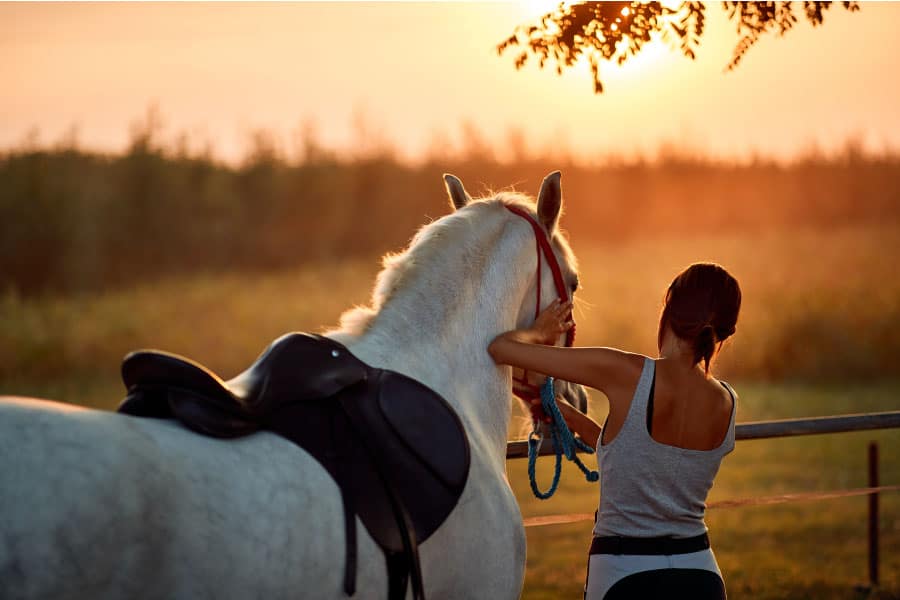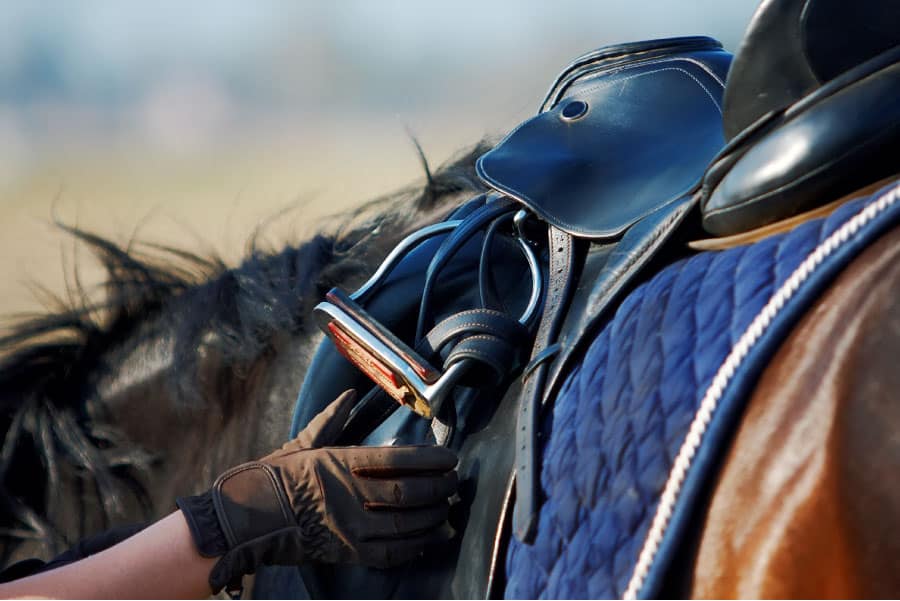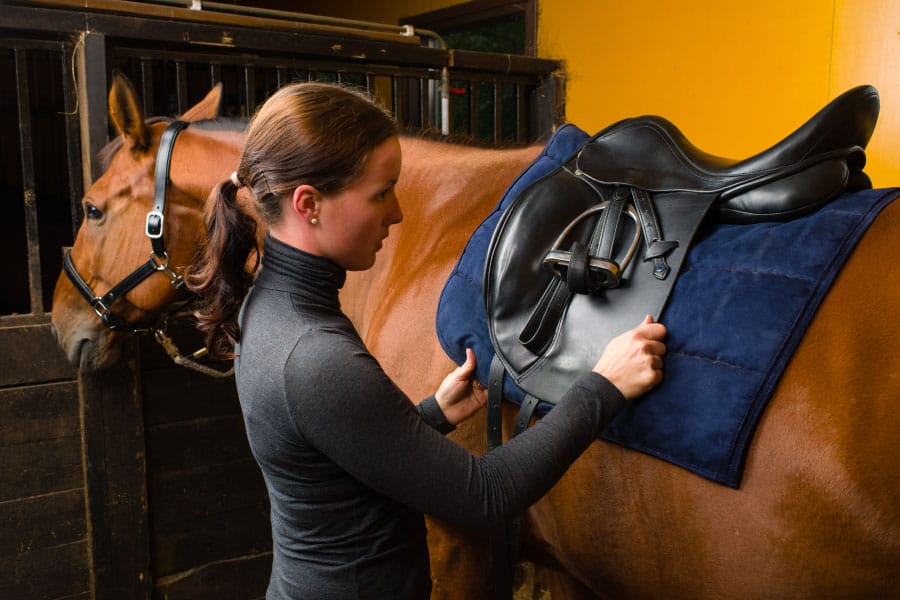- Your source for stall mats, rubber arena footing, arena harrows and arena dust control.

Shying away from you in the stable, lashing out, kicking or biting when tacking up, or acting out when you ride can be an indication that there is something wrong. But, because horses can’t talk, it is a big guessing game. Your horse might be scared of the saddle or saddle related things.
If your horse is scared of the saddle, the most important thing to do is to find out why. Investigate your horse’s history and the possibility of fear due to past incidences. If not, ensure that your horse is 100% pain-free and comfortable. Finding the cause and fixing it will help the horse feel more comfortable with the saddle.
There can be so many reasons as to why your horse is scared of the saddle. It will be a long process to figure out the main reasons and triggers behind the fear or odd behavior. It might not even be fear towards to saddle, but horses react differently to different situations. In this article, I will look at some of the different reasons why a horse would be scared of the saddle and what you can do to help.
Reasons why a horse can be scared of the saddle
Pain
Imagine this, you cannot speak, and your friends force you to do a 5-mile jog with them every morning. But, here’s the problem, your shoes are two sizes too small, you have blisters everywhere, or maybe you sprained your ankle. Sounds fun, right? Your horse could be in the same situation and cannot tell you that he is in pain, but he can show you.
He might not necessarily be scared of the saddle, but it can cause him pain. The best way to find an answer is through a process of elimination where you start with professional opinions, Physiotherapy, saddle fitting, and then veterinary assistance.
Here are some common causes of pain that could cause your horse to act scared towards a saddle:
- Kissing spine – kissing spine is a condition where two or more spinous processes of the spinal column touch. This is a painful but mostly treatable condition. Depending on the severity, treatment can be proper work, steroid injections, or surgery.
- Pressure points leading to muscle spasms – the pressure points are caused by the flocking of the saddle. A lumpy or old saddle can have pieces of flocking that are hard and irregular. This will lead to pressure points under the rider’s weight. The underlying muscles will tense and spasm under these pressure points and cause pain for the horse.
- Saddle on withers – when the saddle is lying too low on the horse, it will put pressure on the withers (the highest point of the spine where the spine and the neck come together). This will cause rubbing and chafing of the skin on the withers and can cause ulceration of the skin. The horse will be very sensitive in that area as this is very painful.
- Saddle sores are basically what the name says; open or ulcerated sores caused by the saddle or the numnah. Continuous rubbing or chafing due to saddle movement on the horse’s back will eventually rub away the hairs and the layers of skin until it becomes raw. This is also why a properly fitted saddle is very important.
- Skin conditions such as rain rot, mange, and other fungal infections will make it painful for your horse to have a saddle in their back.
- Stomach Ulcers cause severe pain in the stomach, and this can cause your horse not to want to work or tighten your girth. A horse that is losing condition, shows frequent colic symptoms, and bites while tacking up usually indicates ulcers, and one can only diagnose ulcers through an Endoscopy.

History if trauma or pain
If you have a horse with an unknown history, it may be possible that the horse has a history of severe back pain associated with the saddle.
White markings on the back of the horse where the saddle should go can indicate scarring. This can give you a clue that the horse has had saddle sores, ulceration of the skin, an ill-fitting saddle, or even rain rot. The horse might be associating pain with the saddle, and this can cause fear.
For more on rain rot, please check my article on “Can You Ride a Horse with Rain Rot? “
“
Abuse
Abuse can also cause general fear of the tack, tacking up, or of humans in their stables.
Under saddle, a horse could have been unnecessarily hit with a whip, booted with spurs, or the rider used harsh bits or tack to train the horse. The horse will start associating the rider or riding in general with abuse, which can also cause fear.
Fear
A horse may not be scared of the saddle, but rather they expect pain, abuse, or other forms of training when being ridden. The horse will then try not to be caught in the paddock or stable, turn away from you in the stable, stand in the corner, act out by kicking or biting or be very slow and unrideable and even develop vices like yanking on the rains, rearing, bucking, bolting and napping.
Young and unbacked horses are generally uncertain of new environments and tack. The way the horse was raised from foaling up until the backing process plays a huge role in the way the horse will react to the backing process and handling.
More experienced handlers and trainers will know that the early stages of the foal’s life are crucial to do desensitization to ensure that the foal is comfortable with overall handling, training, and tack.
Flight response in horses is crucial to their survival, and one needs to understand that when a horse is in an uncertain or uncomfortable situation, the horse will choose to flee. If the horse isn’t able to flee, they will want to fight through biting, rearing, and kicking. It is important to slowly work and desensitize the younger horses to get them used to handling and tack.
Fear unrelated to the saddle can be caused by other pain sources such as the bridle, their bit, their teeth, and their hooves.
Pain while in work
Although muscle atrophy doesn’t necessarily cause pain, it results from pain in the horse and can lead to an ill-fitting saddle.
Muscle atrophy is mainly just shrinkage of the underlying muscle. This usually happens when a horse is not using its muscles properly, and the muscle becomes smaller and weaker. A horse will not use their back muscles properly when they are not working properly or tensing their muscles against pain.

How to help a horse that is scared of the saddle
The most important thing is looking at the horse’s history and the possibility of fear due to past incidences. If that is not the case, you need to ensure that your horse is 100% pain-free and comfortable. If the saddle or the tack is causing pain to the horse, finding the cause and fixing it will help the horse feel more comfortable with the saddle.
If the fear of the saddle is not related to pain, working calmly and slowly with your horse might be able to fix it. If not, try asking for professional or more experienced help. Do not expect your horse to improve in one day; these things take time, and every horse is different.
Here are some tips on what you can do to help a horse that is scared of the saddle:
- Always consult your vet first and rule out any pain, conditions, or underlying symptoms of disease or stress before doing anything else.
- Start slowly without the saddle work with your horse in hand.
- Lunge your horse and doing liberty work can help build a better bond and trust between you and your horse.
- Groom your horse on the saddle area with different amounts of pressure and brushes in an environment where he is most comfortable, like his paddock.
- Start by using a small saddle pad and introduce it to your horse, let them investigate is and maybe even play with it.
- Talk to your horse calmly and rub the saddle pad over their body as if you are grooming them.
- Slowly place the saddle pad onto your horse and let them settle into it. If your horse is calm and relaxed, it’s s a good sign.
- Remember that your safety always comes first. Make sure to wear protective gear and have another person hold or handle your horse. Horses are large prey animals that can get unpredictable.
- Use a lungeing surcingle or something similar and place it gently on top of the saddle pad. If the horse is still calm, reward him, and remove everything.
- The next step is to tie the surcingle like a girth over a saddle pad.
- Once the horse is comfortable with you putting the surcingle and saddle pad on and working on the lunge with it, you can start using a pony pad or saddle.
- Repeat the same steps and routine up until you reach you can put your own saddle on the horse and slowly mount your horse.
- After this, your horse should be fine. If your horse starts freaking out, wait until they calm down, take the tack off, and start again.
Conclusion
To know what to do in the case of your horse being scared of the saddle, you need to find out the reason behind it. There are various reasons why a horse could be scared of the saddle, it can be young and unbacked, or it could have some history with pain/trauma that the horse associates with the saddle.
Finding the cause and rectifying the problem is the best way to keep your horse happy and healthy and to avoid possible larger issues if the underlying problem turns out to be serious.

